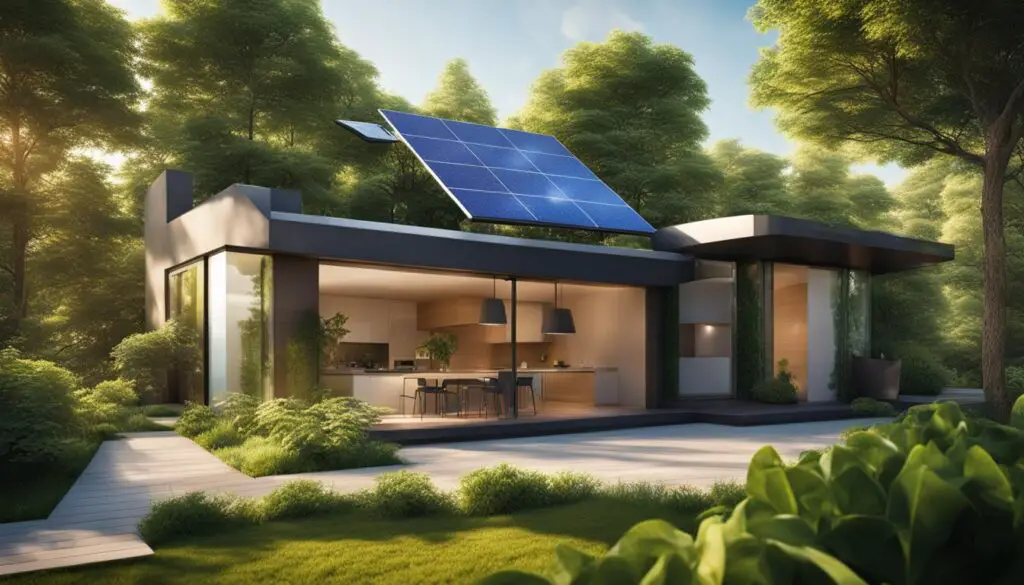Smart thermostats are revolutionizing home climate control, offering enhanced comfort and efficiency. With the ability to remotely control thermostat settings, set schedules, and monitor energy usage, these devices empower homeowners to create a personalized and energy-efficient environment.
As technology continues to advance, the future of smart thermostats holds great promise for further improving home comfort and energy efficiency. From optimizing temperature settings to integrating with renewable energy sources, these devices are evolving to meet the needs of modern homeowners.
Key Takeaways:
- The future of smart thermostats offers enhanced comfort and efficiency in home climate control.
- These devices enable homeowners to remotely control thermostat settings and monitor energy usage.
- Smart thermostats can lead to energy savings and cost savings on utility bills.
- Integration with renewable energy sources and smart home devices further optimize the user experience.
- Advancements in AI and machine learning improve the predictive capabilities of smart thermostats.
The Benefits of Smart Thermostats
Smart thermostats offer numerous benefits to homeowners. They have revolutionized home climate control, allowing for enhanced comfort, energy savings, cost savings, and convenience.
Energy Savings
One of the key advantages of smart thermostats is their ability to lead to significant energy savings. These devices use advanced sensors and algorithms to automatically adjust temperature settings based on occupancy and weather conditions. By efficiently managing heating and cooling, smart thermostats can reduce energy consumption, resulting in lower utility bills and a smaller carbon footprint.
Cost Savings
In addition to energy savings, smart thermostats also offer cost savings. By optimizing temperature settings and avoiding energy waste, homeowners can significantly reduce their utility bills over time. Smart thermostats provide real-time energy usage data, allowing homeowners to monitor and track their consumption, thereby gaining insights and making informed decisions to further maximize cost savings.
Convenience
Smart thermostats provide unparalleled convenience with their advanced features. Voice control capabilities enable homeowners to adjust temperature settings using simple voice commands, providing a hands-free and intuitive experience. Integration with smart home systems allows for seamless control of multiple devices, such as lighting and security systems, from a single app. Moreover, the ability to monitor and control smart thermostats remotely through smartphone apps ensures that homeowners can achieve their desired comfort levels even when away from home.
Smart thermostats offer numerous benefits to homeowners, including energy savings, cost savings, and convenience. With their ability to automatically adjust temperature settings, homeowners can enjoy enhanced comfort while reducing energy consumption and utility bills.
| Benefits | Description |
|---|---|
| Energy Savings | Automatic adjustment of temperature settings based on occupancy and weather conditions leads to significant energy savings. |
| Cost Savings | Efficient management of heating and cooling reduces utility bills and helps homeowners save money in the long run. |
| Convenience | Voice control, integration with smart home systems, and remote monitoring through smartphone apps provide unparalleled convenience. |
Energy Efficiency and Environmental Impact
When it comes to creating a sustainable future, smart thermostats have a vital role to play in improving energy efficiency and reducing our environmental impact. By optimizing temperature settings and learning homeowners’ preferences, these innovative devices help minimize energy waste and lower carbon emissions.
The key to achieving energy efficiency lies in the ability of smart thermostats to adapt to homeowners’ specific needs. Through advanced algorithms and machine learning capabilities, these devices can analyze data, track usage patterns, and make intelligent decisions to optimize energy consumption. By ensuring that heating and cooling systems are only used when necessary, energy is conserved, resulting in reduced carbon footprints.
Additionally, the ability to remotely control and monitor smart thermostats through smartphone apps allows homeowners to make more informed decisions about their energy consumption. This real-time access to data empowers individuals to adjust their temperature settings or even switch off their HVAC systems when they are not needed, further enhancing energy efficiency in the home.
One of the most significant advantages of smart thermostats is their potential to contribute to a sustainable future. By actively reducing energy waste and carbon emissions, these devices align with the principles of sustainability, working towards a cleaner, greener planet.
Benefits of Smart Thermostats for Energy Efficiency:
- Optimization of temperature settings to minimize energy waste.
- Learning homeowners’ preferences to create personalized energy-saving strategies.
- Remote access and control through smartphone apps for real-time adjustments.
- Reduction of carbon footprints by conserving energy and lowering emissions.
By investing in smart thermostats, homeowners can actively contribute to a more sustainable future and make a positive impact on the environment.
Integration with Renewable Energy Sources
As the world embraces the shift towards renewable energy, smart thermostats are at the forefront of integrating with clean energy sources like solar panels. This integration allows homeowners to optimize their energy usage and maximize the benefits of renewable energy, reducing reliance on traditional fossil fuels. By connecting to smart home energy management systems, smart thermostats can intelligently adjust temperature settings based on the availability of renewable energy, ensuring efficient energy consumption.
Incorporating solar panels into the equation enhances the overall sustainability of the home. Solar panels rely on sunlight to generate electricity, a clean and abundant energy source. By adjusting the thermostat settings to align with the solar generation patterns, homeowners can effectively utilize the solar energy available and minimize reliance on the electrical grid.
The seamless integration of smart thermostats with solar panels offers numerous advantages. It allows homeowners to:
- Maximize energy savings by leveraging the power of solar energy
- Reduce carbon footprint and contribute to a greener environment
- Experience greater independence from traditional utility providers
- Monitor and track energy usage patterns to make informed decisions
With this integration, homeowners can enjoy the benefits of renewable energy while maintaining a comfortable indoor environment. Smart thermostats act as the bridge between renewable energy sources and home climate control, creating a harmonious synergy that promotes energy efficiency and sustainability.
To provide a better understanding of the advantages of integrating smart thermostats with renewable energy sources, consider the following table:
| Advantages of Integration | Explanation |
|---|---|
| Maximized energy savings | Optimizing temperature settings based on solar generation patterns allows homeowners to fully utilize the solar energy available, leading to significant energy savings. |
| Reduced carbon footprint | By relying on solar energy and minimizing reliance on the electrical grid, the integration of smart thermostats with solar panels helps reduce carbon emissions, contributing to a greener environment. |
| Greater independence | Integration with renewable energy sources offers homeowners the opportunity to reduce their dependence on traditional utility providers, giving them more control over their energy consumption. |
| Informed decision-making | Smart thermostats provide real-time data on energy usage patterns, empowering homeowners to make informed decisions regarding their energy consumption, resulting in more efficient and sustainable practices. |
By integrating smart thermostats with renewable energy sources like solar panels, homeowners can harness the power of clean energy while enjoying a comfortable living environment. This integration represents a significant step toward a more sustainable future, where energy efficiency and environmental responsibility go hand in hand.
Advancements in AI and Machine Learning
When it comes to the future of smart thermostats, there’s one technology that stands out: artificial intelligence (AI) and machine learning. These cutting-edge advancements are revolutionizing the way smart thermostats operate, allowing them to go beyond simple temperature control and adapt to homeowners’ preferences with incredible precision.
AI and machine learning enable smart thermostats to learn from homeowners’ behavior, gathering data on temperature preferences, schedule patterns, and occupancy habits. By analyzing this data, smart thermostats can intelligently anticipate temperature adjustments, creating a personalized and energy-efficient home environment.
One of the ways AI and machine learning enhance smart thermostats is through the use of predictive algorithms. These algorithms take into account historical data, weather forecasts, and even individual preferences to make accurate predictions about temperature adjustments. By proactively adjusting the temperature, smart thermostats optimize comfort and energy efficiency, ensuring the ideal climate without unnecessary heating or cooling.
“The integration of AI and machine learning in smart thermostats opens up a world of possibilities. These technologies allow the thermostat to adapt to the user’s lifestyle, preferences, and environmental conditions automatically. It’s like having a personal climate concierge.” – David Smith, HVAC expert
With the power of AI and machine learning, smart thermostats become more than just devices; they become intuitive partners in optimizing home comfort. By continuously learning and adapting, these thermostats provide an enhanced user experience, making temperature control effortless and energy-efficient.
Benefits of AI and Machine Learning in Smart Thermostats:
- Personalized comfort: Smart thermostats equipped with AI and machine learning algorithms can tailor temperature settings according to individual preferences, ensuring optimal comfort for each user.
- Energy efficiency: By learning from the data collected, smart thermostats can predict when to adjust the temperature to optimize energy usage, resulting in significant energy savings.
- Reduced environmental impact: The ability of AI and machine learning to optimize energy consumption leads to a reduced carbon footprint, promoting sustainability and environmental stewardship.
With the continued advancements in AI and machine learning, the future of smart thermostats is bright. These technologies not only enhance the functionality of smart thermostats but also pave the way for a more energy-efficient and comfortable home environment.
| Advancements in AI and Machine Learning | Benefits |
|---|---|
| Personalized comfort | Ensures optimal comfort for each user by adapting to individual preferences. |
| Energy efficiency | Optimizes temperature settings to minimize energy consumption and save on utility bills. |
| Reduced environmental impact | Helps lower carbon emissions and contribute to a more sustainable future. |
| Enhanced user experience | Makes temperature control effortless and intuitive for homeowners. |
Enhanced User Experience and Integration
The future of smart thermostats is focused on providing an enhanced user experience and seamless integration with other smart home devices. By integrating with voice assistants like Amazon Alexa and Google Assistant, homeowners can effortlessly control their thermostats through simple voice commands, creating a more intuitive and connected home environment. Voice assistants not only offer the convenience of hands-free control but also enable homeowners to easily adjust temperature settings, set schedules, and monitor energy usage with just their voice.
Moreover, the integration of smart thermostats with other smart home devices, such as smart lighting systems and security cameras, offers a comprehensive smart home solution. Imagine walking into your home, and the smart thermostat not only adjusts your preferred temperature but also coordinates with the smart lighting system to create a welcoming ambiance. Additionally, smart thermostat integration with security cameras allows for seamless automation, such as adjusting temperature settings when no one is home, enhancing energy efficiency.
This integration between smart thermostats and other smart home devices not only enhances convenience but also provides homeowners with a holistic approach to managing their home environment. With a unified control system, users can effortlessly manage multiple devices, creating a harmonious and interconnected smart home experience.
To showcase the seamless integration and enhanced user experience of smart thermostats, consider the visual representation below:
| Smart Thermostat Integration | Benefits |
|---|---|
|
Smart Thermostats in the Internet of Things (IoT)
Smart thermostats are an integral part of the Internet of Things (IoT), a network connecting devices and systems. These IoT-enabled smart thermostats go beyond traditional temperature control by gathering and analyzing data, providing valuable insights into energy usage patterns, environmental conditions, and user behavior.
Through their connectivity and advanced data analytics capabilities, smart thermostats empower homeowners to make data-driven decisions and optimize energy efficiency in their homes. By leveraging the wealth of information collected by these devices, homeowners can gain a deeper understanding of their energy consumption habits and make informed adjustments to enhance overall home comfort while reducing energy waste.
With IoT connectivity, smart thermostats can communicate and interact with other smart devices in the home, such as lighting systems, security cameras, and voice assistants. This integration allows for a truly connected and cohesive smart home experience, where different devices work together seamlessly to enhance convenience and efficiency.
Enhancing Energy Efficiency Through Data Analytics
Data analytics is a key aspect of smart thermostats in the IoT. These devices continuously collect and analyze data related to energy usage, environmental conditions, and user preferences. By examining this data, smart thermostats can identify patterns and trends, enabling homeowners to optimize their energy consumption.
For example, by analyzing historical data and weather forecasts, smart thermostats can predict temperature adjustments in advance, ensuring optimal comfort without unnecessary energy waste. They can also provide personalized recommendations, such as adjusting temperature settings during certain times of the day based on individual preferences and occupancy patterns.
Smart thermostats in the IoT empower homeowners to harness the power of data and make informed decisions to enhance energy efficiency and overall home comfort.
Furthermore, smart thermostats can measure energy usage in real-time, empowering homeowners to track their consumption and identify areas for improvement. This information enables homeowners to understand the impact of their energy usage on the environment and take proactive steps to reduce their carbon footprint.
The Power of Connectivity and Integration
Smart thermostats in the IoT offer a high level of connectivity and integration with other smart devices in the home. This integration allows homeowners to control their thermostats through voice commands, smartphone apps, or even through automated routines established within the smart home ecosystem.
Integration with voice assistants, such as Amazon Alexa or Google Assistant, allows homeowners to adjust temperature settings and control other aspects of their smart home using simple voice commands. For example, with a voice command like, “Hey Google, set the temperature to 72 degrees,” homeowners can effortlessly control their smart thermostat.
By connecting with other smart devices, such as lighting systems and security cameras, smart thermostats can work in harmony to create a more comfortable and secure home environment. They can coordinate temperature adjustments with lighting levels to enhance comfort and energy efficiency while also integrating with security systems to optimize home security.
In summary, smart thermostats in the IoT provide homeowners with the ability to harness the power of connectivity and data analytics to enhance energy efficiency and overall home comfort. By leveraging the insights gained from data analysis, homeowners can make informed decisions about their energy consumption, reducing waste and optimizing comfort. Through integration with other smart devices, smart thermostats create a seamless and connected home experience, further enhancing convenience and efficiency in the modern home.
The Future Looks Bright for Smart Thermostats
The future of smart thermostats holds immense potential for transforming home climate control. With advancements in technology, these devices will continue to offer enhanced comfort, energy efficiency, and convenience for homeowners.
Integration with AI and machine learning will enable smart thermostats to learn and adapt to homeowners’ preferences, creating a personalized and optimized home environment. By analyzing data on temperature patterns, occupancy, and weather forecasts, these devices can anticipate and adjust temperature settings accordingly, maximizing both comfort and energy savings.
Furthermore, the integration of smart thermostats with renewable energy sources, such as solar panels, will contribute to a more sustainable future. By optimizing temperature settings based on the availability of clean energy, homeowners can further reduce their carbon footprint and rely less on traditional fossil fuels.
With seamless integration among smart home devices and voice assistants, smart thermostats will provide a convenient and connected user experience. Homeowners will have the ability to control their thermostats through voice commands, as well as integrate temperature settings with other smart home systems like lighting and security, creating a comprehensive and intuitive home automation solution.
FAQ
What are the benefits of smart thermostats?
Smart thermostats offer numerous benefits, including energy savings, cost savings on utility bills, convenience through features such as voice control and remote access via smartphone apps.
How do smart thermostats promote energy efficiency and reduce environmental impact?
Smart thermostats optimize temperature settings, learn homeowners’ preferences, and track energy usage data to minimize energy waste, lower carbon emissions, and make more sustainable energy consumption decisions.
How can smart thermostats integrate with renewable energy sources?
Smart thermostats can seamlessly integrate with renewable energy sources, such as solar panels, by optimizing temperature settings based on the availability of clean energy, ensuring efficient usage and reducing reliance on traditional fossil fuels.
How do advancements in AI and machine learning improve smart thermostats?
Advancements in AI and machine learning technology enable smart thermostats to learn homeowners’ preferences, predict temperature adjustments based on historical data and weather forecasts, optimizing comfort and energy efficiency.
How do smart thermostats enhance the user experience and integrate with other smart home devices?
Smart thermostats can be integrated with voice assistants, such as Amazon Alexa and Google Assistant, allowing homeowners to control them through voice commands. They can also integrate with other devices like smart lighting systems and security cameras, providing a comprehensive smart home solution.
What role do smart thermostats play in the Internet of Things (IoT)?
Smart thermostats are an integral part of the Internet of Things (IoT) network of interconnected devices. They gather and analyze data to provide valuable insights into energy usage patterns, environmental conditions, and user behavior, enhancing energy efficiency and overall home comfort.
What can we expect for the future of smart thermostats?
The future of smart thermostats holds great potential for transforming home climate control with advancements in technology. They will continue to offer enhanced comfort, energy efficiency, and convenience for homeowners through integration with AI, machine learning, renewables, and other smart home devices.



